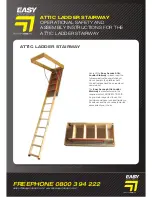
COMBINATION LADDER 3-SECTION
MODEL NO’S:
ACL3.V4, ACL307.V2, ACL312.V3
Thank you for purchasing a Sealey product. Manufactured to a high standard, this product will, if used according to these instructions,
and properly maintained, give you years of trouble free performance.
IMPORTANT:
PLEASE READ THESE INSTRUCTIONS CAREFULLY. NOTE THE SAFE OPERATIONAL REQUIREMENTS, WARNINGS & CAUTIONS. USE
THE PRODUCT CORRECTLY AND WITH CARE FOR THE PURPOSE FOR WHICH IT IS INTENDED. FAILURE TO DO SO MAY CAUSE DAMAGE AND/OR
PERSONAL INJURY AND WILL INVALIDATE THE WARRANTY. KEEP THESE INSTRUCTIONS SAFE FOR FUTURE USE.
1. SAFETY
BEFORE USE:
A)
Check your physical fitness before using a ladder.
DO NOT
use after taking alcohol or any medicine likely to cause drowsiness. Read the label of any drug or medicines.
B
)
When transporting a ladder on the roof rack of your vehicle or in a lorry, make sure that it is secured firmly to avoid causing any
damage.
C
)
Before using the ladder for the first time, check it to ensure that all its parts are in good condition and operate correctly.
D
)
Before use, check the ladder visually to ensure that it has not been damaged and can be used in complete safety.
E
)
Regular checks are essential for all users.
F
)
Check that the ladder is suitable for the job to be done.
G)
DO NOT
use a damaged ladder.
H
)
Clean the ladder of any foreign substances such as wet paint, mud, oil or snow.
I
)
Before using the ladder for professional purposes, risks must be assessed depending on the legislation of the country in use.
POSITIONING AND ERECTING LADDERS:
A)
Ladders must be put up in the right position, i.e. at the correct angle (inclined at about 1 in 4), with the steps or rungs parallel for a
leaning ladder, or completely open in the case of a trestle ladder.
B
)
Any ladder equipped with locking systems; the locks must be in the fully locked position.
C
)
Ladders must be placed on flat regular and firm surface.
D
)
Leaning ladders must always be placed on a flat solid surface and be stabilized before use, for example by using ties or any other
suitable device for ensuring their stability.
E
)
Ladders must never be repositioned from a point high-up.
F
)
When installing a ladder take account of any possible risks of collision, e.g. collisions with pedestrians, vehicles or doors.
If possible, secure any doors (other than emergency exits) and windows on the site.
G
)
Identify all electrical risks on the work-site, e.g. overhead lines or any other bare electrical equipment.
H
)
Ladders must rest firmly on their treads and not be on rungs or steps.
I
)
Ladders must not be placed on any slippery surfaces (e.g. ice, shiny surfaces or surfaces clearly covered with foreign substances)
unless other effective means have been taken to avoid the ladder slipping. Otherwise, make sure that all dirty or contaminated support
surfaces have been adequately cleaned.
USING THE LADDER:
A)
DO NOT
exceed the maximum load allowed for the type of ladder.
B)
DO NOT
try to reach a point too far away from you; your waist should always be between the ladder’s two uprights and your feet on
the same step or rung whilst working.
C)
DO NOT
climb down a high leaning ladder without using an extra safety system (for example, a tie or use of a suitable stabilizing
device).
D)
DO NOT
use a trestle ladder to get up to a higher level.
E)
DO NOT
stand on the top three steps or rungs of a leaning ladder.
F)
DO NOT
stand on the top two steps or rungs of a trestle ladder where there is no platform or support at hand or knee height.
G)
DO NOT
stand on the top four steps or rungs of a trestle ladder with an extension ladder on top.
H
)
Ladders should only be used for minor, short-duration jobs.
I
)
Use non-conductive ladders when working on jobs where electrical power is present.
J)
DO NOT
use ladders outside in unfavorable weather conditions (high winds for example).
K
)
Take all necessary precautions to prevent children from playing on ladders.
L
)
If possible, secure any doors other than emergency exits and windows on the site.
M
)
Climb up and come down a ladder facing it.
N
)
Hold the ladder firmly when climbing or coming down.
O)
DO NOT
use ladders as bridges.
P
)
Always wear suitable shoes for climbing ladders.
Q
)
Avoid all excessive lateral constraints such as when using a drill in brick and concrete.
R
)
DO NOT
stay too long up the ladder without making regular stops (fatigue risks).
S
)
To go up to higher levels, ladders should be extended at least one metre above the height to be reached.
T
)
Light-weight easy-to-handle equipment should be used when on a ladder.
U
)
Avoid works that create side loads on trestle ladders, e.g. for drilling hard materials (brick, concrete, etc.).
Refer to
instruction
manual
Original Language Version
© Jack Sealey Limited
A
CL3.V4, ACL307.V2, ACL312.V3, Issue:2 (1) 30/01/20








